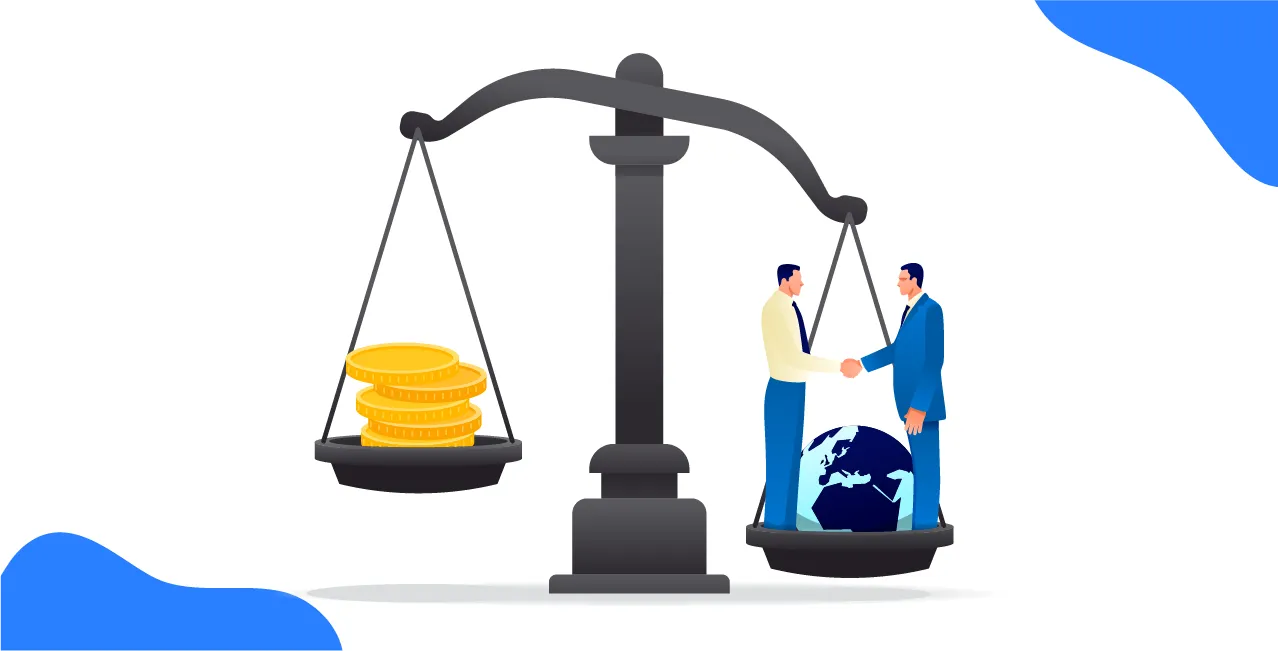
Author
LoansJagat Team
Read Time
6 Min
23 Jul 2025
What is The Balance of Trade : Meaning, Types & Key Economic Impact
The balance of trade (BOT) is the difference between the value of a country’s exports and its imports during a specific period. It forms the largest part of a country’s balance of payments (BOP).
For example, in a year, India exported goods worth ₹9,00,000 crore and imported goods worth ₹7,50,000 crore. The trade balance is positive, meaning India has a trade surplus.
A trade surplus occurs when a country earns more from its exports than it spends on imports. If imports exceed exports, the result is a trade deficit. The BOT is crucial for understanding a country’s economic health and global trade position.
What Shapes a Country’s Trade Balance? A Look Behind the Numbers
A country’s balance of trade depends on many things. Some factors help increase exports, while others raise imports. Let’s explore the key reasons why the balance of trade changes, using easy examples and a simple table to clarify the concepts.
Read More - Future of International Trade
1. Cost of Production
If it costs less to make a product in one country than in another, that country can export more of it. Low costs for land, labour, or machines help companies produce cheaply and sell to others.
Example:
India produces low-cost textiles due to cheap labour, so it exports clothes to countries like the UK and the USA.
2. Cost and Availability of Raw Materials
When a country has easy access to raw materials like oil, coal, or cotton, it can make goods faster and cheaper. If it lacks these, it has to import them.
Example:
Saudi Arabia exports oil because it has large natural reserves, while Japan imports oil as it has very little.
3. Exchange Rate Movements
If a country’s currency becomes weaker, its exports become cheaper for other countries, which boosts sales. But imports become more expensive.
Example:
If the Indian Rupee weakens against the Dollar, Indian goods become cheaper in the U.S., helping India export more.
4. Trade Taxes and Restrictions
Taxes on imports or exports (tariffs) or trade bans can affect the flow of goods. Countries may also sign free trade deals to remove these taxes.
Example:
India and ASEAN countries have trade agreements that reduce import duties, making trade easier between them.
5. Non-Tariff Barriers
Some goods are blocked or slowed down by strict rules, such as health or safety standards. These rules can protect a country’s market but reduce imports.
Example:
Europe has strict food safety rules. If Indian mangoes do not meet the rules, Europe may ban them.
6. Availability of Foreign Currency
Countries need foreign money to pay for imports. If they do not have enough U.S. dollars or euros, they may reduce imports.
Example:
Sri Lanka faced a foreign exchange crisis in 2022 and could not pay for fuel and medicine imports.
7. Price of Local Goods
If locally made goods are expensive, people may buy cheaper foreign products instead. But if local supply increases and prices drop, people may buy local products.
Example:
If Indian smartphones become cheaper and better, Indians may stop buying imported ones, improving India’s trade balance.
Understanding Balance of Trade through Two Views
Keynesian View: Trade Balance and Global Stability
John Maynard Keynes, a British economist, believed that balanced international trade was key to global prosperity. He proposed an International Clearing Union and a global currency called the bancor in the 1940s.
Keynes argued that both debtor and creditor nations could harm the world economy if trade imbalances grew. He wanted to penalise both sides to promote fair trade. His plan let deficit countries borrow from the banks.
Monetarist View: Trade Deficits Aren’t Always Bad
Monetarist economist Milton Friedman viewed trade deficits as signs of strong consumer demand, not weakness. He argued that if a country imports more, it means foreigners are investing or saving there.
Friedman believed markets self-correct through currency adjustments, making exports cheaper over time. He even said that if foreign money never returned, the country would still gain by receiving goods in exchange for paper money.
Balance of Trade vs Balance of Payments: What’s the Difference?
When discussing how a country manages its financial transactions with other countries, two key terms emerge: Balance of Trade and Balance of Payments. Although they sound similar, they are not the same.
Example of Balance of Trade:-If India exports goods worth ₹500 crore and imports goods worth ₹600 crores, it has a trade deficit (unfavourable balance) of ₹100 crore. But if India exports more than it imports, it has a trade surplus (favourable balance).
Example of Balance of Payments:-Imagine India imports more goods than it exports (trade deficit), but also receives large foreign investments or income from Indian workers living abroad. This money can cover the gap and keep the Balance of Payments stable.
Balance of Trade Through Time: From Mercantilism to Modern Policy
Many European countries once followed mercantilism, a belief that a country becomes richer by exporting more than it imports. A trade surplus was seen as a sign of national strength.
Also Read - Stock Market Impact
In 1549, a famous quote warned:
“Buy no more from strangers than we sell them, or we will make ourselves poor and make them rich.”
Key Historical Points
- Mercantilism: Sell more, buy less to grow rich.
- Colonial Trade: Colonies exported raw goods and imported finished goods.
- Bullionism: Wealth measured in gold and silver; trade surpluses increased it.
- Early Warnings: Buying more than selling was seen as dangerous.
- Thomas Mun: Promoted trade surplus as the rule for a national treasure.
Since the 1980s, the U.S. has run a growing trade deficit, especially with China and Japan. These nations now hold large amounts of U.S. debt.
Countries like Germany, Japan, and China often run trade surpluses. Their people save more and spend less, helping their export-based economies.
Modern Patterns
- U.S. trade deficit: High imports, low savings, rising debt.
- Asian surpluses: High savings, strong exports.
- China: Accused of modern mercantilism.
Conclusion
The balance of trade shows the difference between what a country exports and what it imports. If it sells more goods to other countries than it buys, it has a trade surplus. If it buys more than it sells, it has a trade deficit.
A trade surplus can help the economy grow, while a trade deficit may lead to more borrowing or foreign debt. Many factors affect the balance of trade, such as production costs, currency value, and trade rules. In short, the balance of trade helps us understand how a country earns and spends money in global trade.
FAQ’s
1. What is the balance of trade?
The balance of trade is the difference between a country’s exports and imports. It shows whether a country sells more goods than it buys.
2. What is a trade surplus?
A trade surplus happens when a country exports more goods than it imports, earning more from trade.
3. What is a trade deficit?
A trade deficit means a country imports more goods than it exports, spending more than it earns from trade.
4. Why is the balance of trade important?
It shows a country's trade strength. A good balance supports growth, while a poor one may lead to debt or currency issues.
5. What affects the balance of trade?
Production costs, currency rates, trade policies, and demand for goods all affect how much a country imports and exports.
Other Informative Pages | ||
About the Author

LoansJagat Team
‘Simplify Finance for Everyone.’ This is the common goal of our team, as we try to explain any topic with relatable examples. From personal to business finance, managing EMIs to becoming debt-free, we do extensive research on each and every parameter, so you don’t have to. Scroll up and have a look at what 15+ years of experience in the BFSI sector looks like.

Quick Apply Loan
Subscribe Now
Related Blog Post


